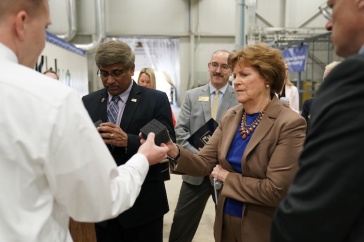When mechanical engineering students Adam Lovell ’17 and Alec?Cunningham ’17 chose to pursue their passion for cycling as a research project, there were limited options where they could conduct full-scale testing.
Lucky for them, UNH's Flow Physics Facility — the largest boundary layer wind tunnel in the world — happens to be one of those suitable places.
Lovell and Cunningham, members of the UNH cycling team, were interested in exploring the impact of drafting — riding directly behind another cyclist to save energy — during crosswinds, a subject with little published research. The pair was among more than 300 students who presented research findings during the Undergraduate Research Conference’s Interdisciplinary Science and Engineering Symposium (URC-ISE) in the Whittemore Center Arena on Wednesday.
“The large number of variables posed a?challenge, but figuring their effects is very rewarding,” says project advisor Ivo Nedyalkov, a lecturer in mechanical engineering. “Adam and Alec?are?very enthusiastic and have being?doing an outstanding job.”
The research began with a 1:11 scale prototype model of cyclists in different formations of up to four cyclists that were tested in the wind tunnel. With plenty of real-world riding experience, Cunningham says initial findings were as expected.
“When we started to do offset tests, that’s when things got very interesting,” he says. “We started to discover things I did not expect.”
The research shows that ideal formations depend on the shape and size of the cyclists in the formation and size of the cyclists. But to better understand initial findings, they expanded the project to include testing in the Flow Physics Facility with Cunningham and Lovell serving as the cyclists. The additional inquiry sought to better understand the positioning of the drafting cyclist and how wheel rotation impacts the results.
Award Winners
Lovell and?Cunningham took top honors at Wednesday's Interdisciplinary Science and Engineering Symposium (ISE), winning the mechanical engineering research category for their project "Cyclist Aerodynamics Analysis in Cross Wind."?
“Learning how to utilize the drag balance in the student wind tunnel and the instruments in the Flow Physics Facility has been?challenge but rewarding,” says Lovell. ?
Data analysis also presented its challenges, but the work paid off: Their studies of favorable drafting position will be published in a conference paper from the summer meeting of the American Society of Mechanical Engineers Fluids Engineering Division. The team plans to publish a journal paper with all findings upon finishing their testing in the wind tunnel.
Perhaps as important, Cunningham and Lovell plan to apply their knowledge to gain an edge on the competition in future cycling races.
“The results we got can now be applied to real riding and racing,” says Cunningham. “Obviously, the wind is very complex as it changes all the time, but now we can understand what to do much better.”
More Undergraduate Research Conference coverage
-
Written By:
Brooks Payette | College of Engineering and Physical Sciences



















































